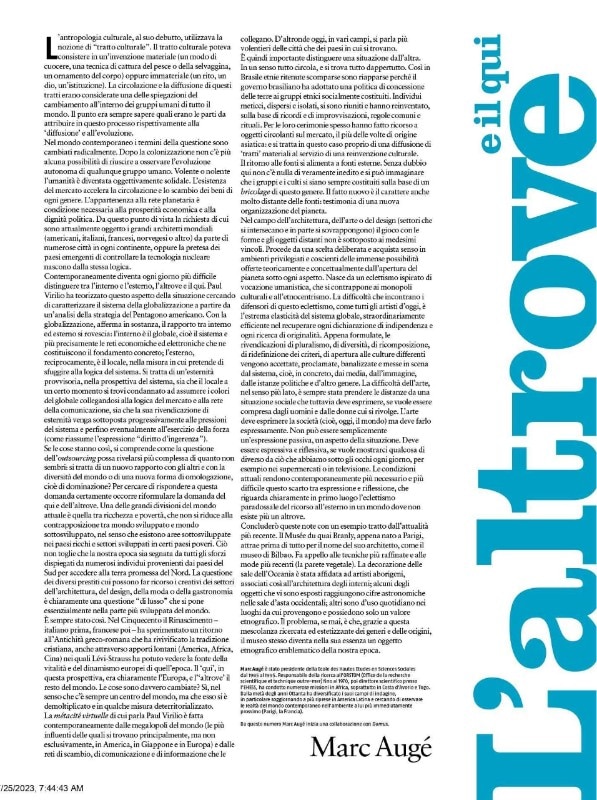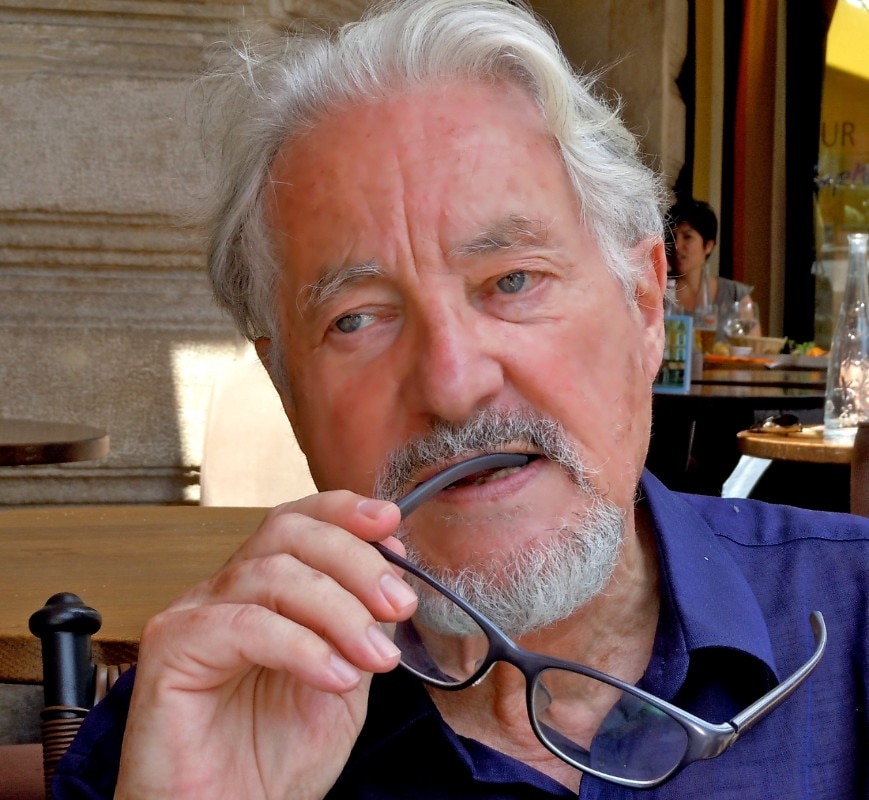“Like it or not, humanity has become objectively interdependent”. It can be said that much of Marc Augé’s reflection in recent decades has focused around this statement, especially around the multiplicity of semantic nuances affecting the last word: around the connection, in a word, between spaces, identities and relationships, in a world that was factually becoming – in material, political, cultural, human terms – globalized. Investigating the self-representation of societies since the 1970s, the French anthropologist had become universally known for having created a concept that was perhaps the most effective in outlining a historical era, the nonplace, an anonymous space of circulation, belonging nowhere and possibly repeatable everywhere, translatable into airports, hotels, shopping malls and so on (Non-Lieux, introduction à une anthropologie de la surmodernité, is the title of Augé’s 1992 fundamental book).
In a globalized scenario where belonging to the system and its connections – the global – becomes “the inside”, while it is the local that becomes “the outside”, the elsewhere, in a scenario where spatial determination plays such an important role, which is then the role of architecture, of design, of art? Augé posed this question in the editorial he wrote for Domus in September 2006, published on issue 895. We read those words again to retrace a thought that remains fundamental to the evolution of our contemporary culture and the understanding of our society.
The elsewhere and the here
Cultural anthropology in its early days adopted the notion of "cultural traits". These cultural traits could have been a material invention (a manner of cooking, a technique of catching fish or game, a body ornament) or an immaterial one (a rite, a god, an institution). The circulation and diffusion of those traits were regarded as one of the explanations for change within human groups across the world. The question was always to find out what were the respective parts of "diffusion" and of evolution in that process.
In the contemporary world, however, the terms of the question have radically changed. Since colonisation, there has been no further chance to observe the autonomous evolution of any human group. Like it or not, humanity has become objectively interdependent. The existence of markets accelerates the circulation and exchange of goods of all sorts. Economic prosperity and political dignity necessitate the condition of belonging to the planetary network. From this point of view, the projects for which leading world architects (American, Italian, French, Norwegian or others) are today so much in demand by numerous cities across the globe, or the demand by emerging countries to control nuclear technology, are governed by the same logic.
Likewise it is getting more difficult as each day passes to distinguish between exterior and interior, the elsewhere and the here. Paul Virilio has theorised this aspect of things by trying to characterise the system of globalisation on the basis of an analysis of the U.S. Pentagon’s strategy. Essentially he tells us that with globalisation the relationship between interior and exterior is reversed: the interior is the global, meaning that the system is more precisely the economic and electronic networks that constitute its concrete basis; while, reciprocally, the exterior is the local, insofar as it claims to escape the logic of the system. This is a provisional exteriority, in the perspective of the system, regardless of whether the local may ultimately find itself obliged to assume global colours by adhering to the logic of the market and of the communications network, or whether its claim to exteriority is steadily subjected to pressure from the system and even eventually to the exercise of force (as summed up in the expression "right to interfere").

If that is so, the question of outsourcing can clearly prove more complex than it may seem: does it mean a new relationship to others and to the diversity of the world, or a new form of uniformity, in other words domination? To attempt to answer this question, it is undoubtedly necessary once again to raise the issue of the here and the elsewhere. One of the main divisions of today’s world is between rich and poor, which does not boil down to the contrast between the developed world and the underdeveloped one, in the sense that there are underdeveloped zones in the rich nations and developed sectors in certain poorer ones. This in turn does not prevent our time from being conspicuous for all the efforts by numerous nationals from countries in the South to gain access to the promised land of the North. The question of the different loans on which creators in the fields of architecture, design, fashion or gastronomy can rely is clearly one of “luxury”, arising essentially in the more developed part of the world.
It has always been like that. In the 16th century, the Renaissance, Italian first and French later, went through a return to Graeco-Roman antiquity, which redirected the Christian tradition, and also through more remote connections (America, Africa, China). In these Lévi-Strauss saw the source of European vitality and dynamism in that period. The “here”, in this perspective, was clearly Europe, and the "elsewhere" the rest of the world. Now have things really changed since? Yes, in the sense that there is still a centre of the world, but that it has been geared down and in some measure de-territorialised. The métacité virtuelle which Paul Virilio talks about consists both of the world’s megapoles (the most influential of which are mainly situated, but not exclusively, in America, Japan and Europe) and of the networks of trade, communication and information that join them together. Moreover people are inclined to talk today, in numerous spheres, more readily of cities than of the countries in which they are located. So it is important to distinguish situations. In a sense, everything circulates and everything can be found everywhere.
Thus, in Brazil, ethnic groups which people believed had disappeared have reappeared, because the Brazilian government has pursued a policy of allocating land to socially constituted ethnic groups. Half-caste, scattered and isolated individuals have reunited and reinvented, on the basis of memories and improvisations, common rules and rituals. For their ceremonies they have often turned to objects to be found on the market, of Asian origin in most cases. Here is a clear instance of material “traits” at the service of a cultural reinvention. The return to sources borrows from outside ones. Of course there is nothing really unprecedented about that, and it can be imagined that groups and cults have always formed on the basis of a “bricolage” of this sort. What is new, though, is the possibly very remote character of those sources, testifying to a new organisation of the planet.
_page-0001.jpg.foto.rmedium.jpg)
In architecture, art or design (which partly intersect and overlap), the play of remote forms or objects does not ensue from the same restraints. It stems from a deliberate choice, and makes sense within the privileged, conscious framework of immense possibilities theoretically and ideally offered by the opening of the planet to everybody’s gaze. It has to do with an eclecticism inspired by a humanist vocation, opposed to cultural monopolies and to ethnocentrism. The difficulty which the defenders of an eclecticism of this kind are up against, like all artists today, is the extreme suppleness of the global system, extraordinarily adept at taking over all declarations of independence and every search for originality. Barely even formulated, the claims to pluralism, diversity, recomposition, redefinition of criteria and openings to different cultures are accepted, proclaimed, trivialised and displayed by the system, that is to say, concretely, by the media, the image, political and other instances.
The difficulty of art, in the widest sense, has always been to keep its distance from a state of society which it has to express, however, if it is to be understood by the men and women to whom it is addressed. Art must express society (which today means the world). But it has to do so specially. It cannot just be a passive expression, an aspect of the situation. If it is to show us something other than what we see every day, for example at the supermarket or on television, it must be expressive and reflexive. Present conditions make it both necessary and more difficult to separate expression from reflection, which clearly concerns primarily the paradoxical eclecticism of a recourse to the exterior, in a world in which there is no longer an elsewhere.
I shall conclude these few remarks with an example borrowed from recent news. The quai Branly museum, which has just been opened in Paris, is attractive because of its architect, as was the Bilbao. It harnesses the most sophisticated techniques and the most recent fashions (its vegetal wall). The decoration of its Oceanian rooms is entrusted to Aboriginal artists, thus associated with its interior architecture; certain objects exhibited there fetch astronomical prices at western auction houses; others are in everyday use in their places of origin and are only of ethnographic value. The problem, if any, is that as a result of this smoothly aestheticised mixture of genres and origins, the museum itself becomes essentially an emblematic object of our time.
Marc Augé was the president of the Ecole des Hautes Etudes en Sciences Sociales from 1985 to 1995. Director of research at ORSTOM until 1970, then director of studies at EHESS, he carried out a number of trips to Africa, mainly on the Ivory Coast and Togo. During the mid 1980s, his fields of observation diversified and he made many more trips to Latin America and became an observer of realities in the contemporary world in his more immediate environment (Paris, France).
Opening image: Marc Augé (June 2010). Courtesy Cl. Jean Jamin. @Charles Mallison



